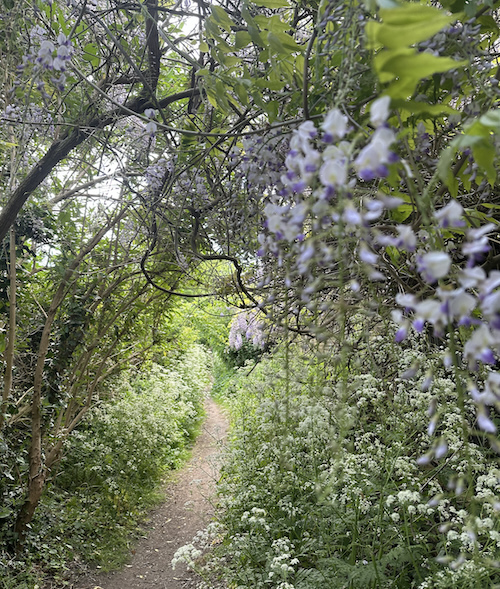I’m not convinced by the idea of AI throwing everyone out of jobs or taking over the world, but I thought I should read up some thoughtful writing on the subject, so I turned to Neil Lawrence’s 2024 book (recently released in paperback), The Atomic Human. I learned a lot from it, but I was struck by the meandering tales he introduces of characters from the past, ranging from Socrates, via his grandfather to the Terminator. It wasn’t that these stories didn’t have a point. Of course they all did, but the characters wove themselves into the fabric of the text in ways that sometimes seemed to me to obscure more than they helped.
I found this mode of writing frustrating, and not necessarily illuminating. Then I read the review of the book by Adam Rutherford, which appeared in the Guardian last year, and realised how absolutely right Adam was about the unhealthy preponderance of great white men of the past (as well as the Terminator with, apparently, 16 appearances dotted around the text) in these stories. As he puts it
‘In a chapter called Enlightenment, we veer from Great Man classic tales of Isaac Newton, Winston Churchill and Stephen Hawking, down a cul-de-sac visiting William Blake and Michelangelo, then to Lewis Carroll and Bertrand Russell, and all the way to Elon Musk, via many more.’
That is a fine old collection of the great and good, but, as he goes on to say
‘I scanned the index and found that 15 women are named in this 448-page book (16 if you count the goddess Hera), as well as the mention of two groups of anonymous women (Royal Navy Wrens, and the women of Bletchley Park). Winnie-the-Pooh, a fictional bear who as far as I am aware, did not make any pronouncements on intelligence research, or the AI revolution, is mentioned 17 times.’
I will admit that, despite all I have said and written about the role of women in science, I had not picked up the gender bias in the text; the woman who appeared most I think was Amelia Earhart. So conditioned am I – along with most of the population but unlike Adam – I had failed to spot that women were all but invisible. The frequent appearance of Winnie-the-Pooh I had spotted. If I were an adolescent girl. maybe I would have been more aware of the absence of role models I could identify with and thereby received an unwanted subliminal message.
Yet, looking more widely away from the book, the few women who did get opportunities to shine in the scientific and technical world from the late nineteenth century on, are beginning to be allowed to come out of the woodwork. Around the time I finished Lawrence’s book, I came across the following on Bluesky
This post highlights a group of women from the 1920s who are finally getting some attention for what they contributed to quantum physics. As time goes on, more and more women are being identified as having made significant if, in general, unsung contributions.
Locally, I could identify Katherine Blodgett, an American who came to Cambridge to work at the Cavendish in 1924 under Ernest Rutherford, with the support of Irving Langmuir, her boss at GE based in Schenectady in upstate New York. She was the first woman to gain a PhD from the Cavendish, so you might have expected her to appear in the 2016 voluminous history of the department written by Malcolm Longair (its former head) Maxwell’s Enduring Legacy. But no, there is no mention of her at all. Some years later (2023) the department did try to rectify this error by writing a blogpost about her, identifying her seminal role (although its appearance is somewhat marred by the fact the hypertext relating to the photos has not been correctly formatted so the photo of her sitting in the midst of a sea of men is not online).
However, I knew about her long before that, because I had to walk past the wall of photos of generations of graduate students every day to get to the canteen or library. She stood out, along with a few other women (sometimes in very fine, if less than convenient hats) from around the turn of the century. They, presumably did not get PhDs, not least because no one did at Cambridge until 1919. But, beyond the photos, Langmuir-Blodgett films were something I lectured about, and some of my research students used them in their research (they are monolayers, or multiple monolayers, of surfactants laid down on glass or liquid surfaces). Sadly, the Cavendish cannot lay claim to their invention as this was done back at GE and not as part of Blodgett’s PhD.
I think this episode about Blodgett is symptomatic of how so much of our scientific history is narrated: great men of science, with the few women who were involved traditionally being invisible but at last increasingly being brought into focus.
For instance, the staff who did all the calculations at the Harvard Observatory with Edward Pickering were all female from 1880 onwards (a group sometimes unkindly referred to as Pickering’s Harem). This wasn’t a great act of liberalism on his part, but simply because they were cheap. According to David Grier’s book (When Computers were Human), Pickering apparently said
‘a skillful [astronomical] observer should never be obliged to spend time on what could be done equally well by an assistant at a much lower salary.’
Annie Jump Cannon and Henrietta Swan Leavitt were two of these women, whose names are now much more widely known in the field, for their seminal work in classification of the stars and measurement of distance respectively. They were far more than simply cheap labour.
Pickering’s argument on cost was essentially the same one that had been made by William Herschel when he applied – successfully – to Queen Charlotte for funding for his sister Caroline to work as his assistant, more than 100 years earlier.
‘Nor could I have been prevailed upon to mention now, were it not for her evident use in the observations that are to be made…and the increase of the annual expense which, if my Sister were to decline, that office would probably amount to nearly one hundred pounds more for an assistant.’
As has been seen in the case of female composers (and as I wrote about previously on this blog), more and more significant women from the past are finally getting some attention in orchestral programmes and on Radio 3. It is high time women like Katherine Blodgett find their place in write-ups of science’s history. Whether if Neil Lawrence had tried harder to find anecdotes of women who would have fitted into his narrative he could have increased the number of references to women in his book I can’t tell. But I suspect it ought to have been possible to weave in Hedy Lamarr’s contribution to the development of frequency hopping (literally, not just a pretty face in her case) or some other notable names such as Ada Lovelace, Wendy Hall, Grace Hopper or Marissa Mayer, to name just a few who come immediately to my mind.
It would be nice to think in general authors would try harder to diversify their anecdotes, at least when considering the past half century or so. We don’t always need to quote Churchill or Newton, particularly if we are discussing a new field like AI. However, knowing Neil a little, I am quite sure if writing the book again but with the memory of Rutherford’s review, he would want to find more female examples to quote. I suspect he, just like me when I read the book, simply failed to notice the bias because culturally we are all so used to it that it is invisible. That’s what has to change to move towards an equitable society.










